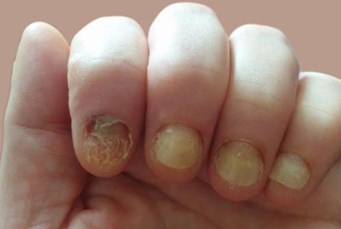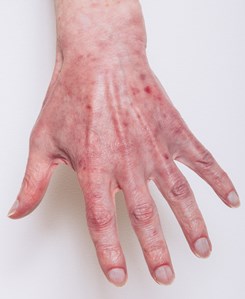23 August 2024
Nail Psoriasis General Guidance & Tips
Nail psoriasis is a surprisingly common type of psoriasis. It affects nearly 50% of people who have psoriasis. It can range from mild to severe and can affect nail appearance, texture, and sometimes cause discomfort.
Understanding and managing nail psoriasis can make a big difference in daily life. Especially as our hands are involved in so many day-to-day tasks, from typing and writing to shaking hands.
What is Nail Psoriasis?
 Nail psoriasis occurs when psoriasis affects the nails. You might see it in your fingernails, toenails, or both. It is particularly common for people with psoriatic arthritis.
Nail psoriasis occurs when psoriasis affects the nails. You might see it in your fingernails, toenails, or both. It is particularly common for people with psoriatic arthritis.Some of the most common signs include:
- Discolouration: Nails may turn yellow-brown or develop white patches.
- Pitting: Small dents appear on the nail surface.
- Thickening: Nails may become thicker, making them harder to trim.
- Onycholysis: The nail may lift or detach from the nail bed.
These symptoms can be confused with a fungal infection, so it’s important to get a proper diagnosis from a healthcare professional.
Causes and Triggers
Psoriasis is an immune system condition characterised by inflammation, and nail psoriasis is no different. For some people, nail injury, the Koebner Phenomenon (where psoriasis appears at sites of skin trauma), or an infection can trigger nail psoriasis.
Interestingly, nail psoriasis can occur without other psoriasis symptoms on the skin, making it harder to identify.
Treatment Options
Treating nail psoriasis can be challenging due to the constant use of our hands and nails, and the slow growth of nails in general. However, the following treatments can help improve symptoms:
- Topical Treatments: Steroid-based topical treatments can be effective but are not recommend for long-term use.
- Vitamin D-based Topicals: Vitamin D-based treatments also help, but you should avoid using them with steroid creams.
- Antifungal Creams: If a fungal infection is present, antifungal cream may be necessary alongside other treatments.
- Light Therapy and Systemic Treatments: If treating psoriasis elsewhere on the body, UV light therapy and systemics may be recommended. These are not typically prescribed for nail psoriasis alone and nail improvements may take longer to show up, so it is important to be patient.
Practical Nail Care Tips
Even with treatment, good nail care is essential for managing symptoms and preventing further damage. Here are some practical tips:
- Avoid Nail Trauma: Don’t pick at or push back your cuticles, as this can damage the skin around the nail.
- Keep Nails Dry: Thoroughly dry your nails after washing your hands or showering. Use a tissue to soak up moisture.
- Trim Carefully: Use nail clippers instead of scissors and be cautious with the corners to avoid ingrown nails.
- Keep Nails Short: Short nails are less likely to catch and cause damage.
- Stay Clean: Regularly clean under your nails to prevent bacterial infections.
- Nail Enhancement Choices: If you get regular nail treatments (like acrylics or gel fillers), consider using nail varnish or press-on nails instead. These gentler options can help prevent damage. Be sure to inform your nail technician about your nail psoriasis.
 When to Seek Help
When to Seek HelpIf you notice any changes in your nails, such as discolouration, pitting, or thickening, consult your GP or dermatologist.
Nail psoriasis can affect not just your appearance but affect your day-to-life. You can find more about it on the nail psoriasis information sheet.
With the right care and treatment, you can manage symptoms effectively and improve your nail psoriasis.